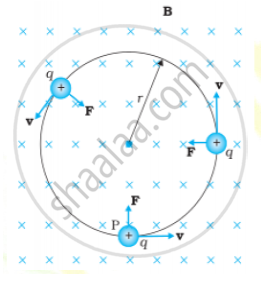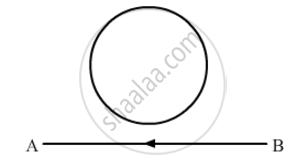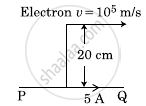Advertisements
Advertisements
प्रश्न
A particle of charge ‘q’ and mass ‘m’ is moving with velocity .`vecV` It is subjected to a uniform magnetic field `vecB` directed perpendicular to its velocity. Show that it describes a circular path. Write the expression for its radius.
उत्तर
A charge ‘q’ projected perpendicular to the uniform magnetic field ‘B’ with velocity ‘v’. The perpendicular force F = qv × B acts like a centripetal force perpendicular to the magnetic field. Then the path followed by charge is circular as shown in the figure below.

The Lorentz magnetic force acts as centripetal force thus,
`qvB =(mv^2)/r`
`r =(mv)/(qB)`
Here, r = radius of the circular path followed by charge projected perpendicular to the uniform magnetic field.
संबंधित प्रश्न
Use this law to find magnetic field due to straight infinite current carrying wire.
The electric current flowing in a wire in the direction from B to A is decreasing. Find out the direction of the induced current in the metallic loop kept above the wire as shown.

A long straight wire in the horizontal plane carries a current of 50 A in north to south direction. Give the magnitude and direction of B at a point 2.5 m east of the wire.
A straight wire carrying an electric current is placed along the axis of a uniformly charged ring. Will there be a magnetic force on the wire if the ring starts rotating about the wire? If yes, in which direction?
The magnetic moment is NOT associated with ____________.
Direction of magnetic force on a positive charge moving in a magnetic field is given by ______.
A magnetic field exerts no force on
An infinitely long straight conductor carries a current of 5 A as shown. An electron is moving with a speed of 105 m/s parallel to the conductor. The perpendicular distance between the electron and the conductor is 20 cm at an instant. Calculate the magnitude of the force experienced by the electron at that instant.

The unit Wbm-2 is equal to ______.
What is the relation between Tesla and Gauss?
